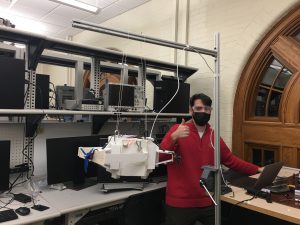This week, I worked mostly on the hardware platform for the device, and the Arduino software. We are using an Arduino for now communicating with the Pi over UART in order to control the motors. This is in the interim, and we may remove this in the long term using threads or something similar to allow for continuous control of the motors during flight. The new code took PWM values from the raspberry pi python vectorization code and runs the motors accordingly, and handles I/O and start/stopping. I also worked on a new custom soldered perfboard that integrates all the I/O and PWM cables to make the inside of the system less cleaner, and have it mount to the Arduino so there isn’t risk of disconnecting a cable during flight. I added another power splitter to the power distribution board I made as well, in order to drive 3 ESCs/motors concurrently for the demo. In addition, I helped during the drop tests this week where we diagnosed some issues with motors causing spin and swing, and are working to address those issues. We believe that adding some weight to the system can help reduce this issue as well. I also helped develop the interim demo test apparatus we want to use to demonstrate our project working in a smaller scenario. We are currently working to calibrate our mounted camera such that the target detection will reflect in motor driving correctly. We are mostly on schedule currently, with basic integration essentially complete for the demo. The final housing got pushed because the interim one is functioning. In the coming weeks, I hope to continue flushing out bugs in the integrated system, as well as verifying that our thrust tests were accurate and that we can reduce the swaying by adding a little more mass to the system.
Team Status Report for 11/6/21
This week, we completed several more drop tests and prepared the interim demo for next week. We inferred from last week’s tests that there was not enough thrust to move the 3 meters that we wanted. Our idea then was to use two motors on each of the three sides instead, to hopefully double the thrust. At a TA’s suggestion, we also acquired larger propellers as another way of increasing the thrust. The thrust tests, done on a scale, showed 600 grams with double propellers. It was approximately 600 grams with the large propellers as well, but these were not meant for the motors we had so they couldn’t be installed properly without vibration.
We did a few drop tests on the double propeller arrangement we put together last week. We repeated the tests several times, each time adjusting for different variables. The first time around, we noticed there was swing so we changed the Arduino code to start after the drop began. On later tests we had to address spin and lack of movement. We were unable to modify the design so that the propulsion system would move where we wanted. This is the area of our project that is the most uncertain at this point. To mitigate risk, the next time we get the chance to do a drop test we want to add balanced weights to the inside of the device. We think that a persisting problem is the lack of tension between the parachutes and the device. With this change movement will not be impeded by swing or spinning. Video
For our interim demo, we set up an apparatus that will suspend our device 1.3 meters off the ground, while we move around a target image of 10cm diameter below the camera on the bottom. This models our actual 13 meter drop height against a 1 meter target diameter. We will show that we can activate the propellers in the correct direction based on the target’s relative location.

